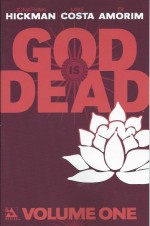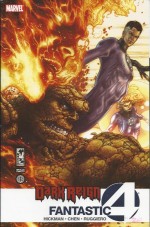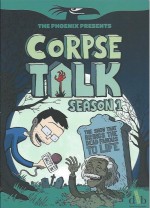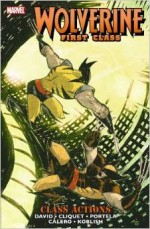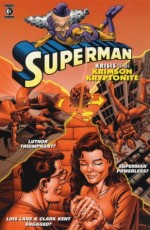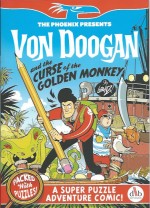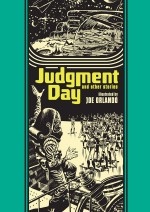
By Nicolas De Crécy translated by Joe Johnson (NBM ComicsLit/Louvre: Musée du Louvre Éditions)
ISBN: 978-1-56163-855-0
In 2005 one of the greatest museums in the world began an intriguing ongoing project with the upstart art form of comics; inviting some of the world’s most accomplished masters of graphic narrative to create new works in response to the centuries of acquired treasures residing within the grand repository of arts, history and culture.
The tales are produced in close collaboration with the forward-looking authorities of the Louvre, and always push the envelope of what can be accomplished by master craftsman inspired by their creative antecedents and forebears. These are no thinly-concealed catalogues of exhibition contents gift-wrapped in cartoon terms to gull potential visitors off their couches and into a stuffy edifice of public culture, but vibrant and challenging comics events calculated to make you think again about what creativity and history mean…
The first of those stellar tomes, originally released as Période glaciaire, has been recently repackaged as a deluxe and lavish oversized (286 x 222mm) hardback edition by NBM giving a readers that rarest of things – a second bite of the cherry…
Born in Lyon in September 1966 into a large family of artistic overachievers,Nicolas de Crécy was, in 1987, part of the first graduating class of students from de l’école de Bande dessinée des Beaux-Arts d’Angoulême.
After working at Studios Disney at Montreuil, he published his first album Foligatto in 1991. Since then he has produced more than thirty albums; both one-off books such as Journal d’un fantôme, Escales, Plaisir de myope and La Nuit du grand méchant loup and series/serials such as Léon la came, Monsieur Fruit and Salvatore.
He is justly considered a wünderkind of French comics and his unique take on the role of the Louvre is – typically – boldly off-kilter, ingeniously amusing and fantastically sardonic…
Thousands of years from now Earth is a frozen dustheap. Scrabbling through its barren remains one day comes a turbulent group of scientists and archaeologists. The humans are a tendentious bunch, constantly bickering and pontificating on what the civilisation they are obsessed with understanding was like. Most have their own theories and perhaps only looking for finds to validate their views.
Far more open and philosophical are the tubby talking dogs who act as frontrunners; their hyper-keen noses sniffing out areas where potential finds are buried. Especially sensitive – in every meaning of the term – is Hulk.
The rotund canine rogue can feel the tension in the party and when he sleeps (as often as possible) he has strange dreams and visions of beautiful old things…
When he and official expedition leader Juliette are briefly separated from the group in a storm the ensuing calm reveals an ancient structure freshly uncovered. Soon the humans are all over the “temple†and making grand plans, but the irascible mutt knows this find is mere dross and rubbish…
Another angry discussion results in top historian Paul being left behind to research and catalogue the temple whilst the others press on to uncover the fabled lost metropolis buried somewhere in this desolate region…
Hulk isn’t fooled: he sees that imperious alpha male Gregor has designs on Juliette and is slowly isolating her from the others. After she ignores the canny canine’s warnings, Hulk wanders off into the cold night and next morning impatient Gregor convinces the party to go on without him.
Alone and no longer distracted, Hulk’s incredible faculties detects a faint scent and he begins to dig down. Before long he has broken into a stone vault filled with fascinating artefacts and, as ever, following his nose discovers a mesmerising maze of corridors, revealing incredible facts about the lost civilisation…
Under the cold light skies above, Juliette and Gregor clash over who is truly in charge and poor studious Joseph suffers for his chivalry when he intervenes. Further interpersonal violence is only prevented when the treacherously unstable landscape shifts and from the icy crust an ancient structure begins to inexorably rise.
Hysterically elated, Gregor drags the stunned archaeologists into the fabled metropolis and all are stunned by the images and artefacts they find. Soon they are frantically hypothesising, guessing and just plain spitballing as they plunge deeper and deeper into the still shaky and shifting edifice. Entranced and intoxicated by the panoply of pictures and statues, the humans’ imaginations are running amok…
Soon from outside Esteban calls out to them – he has spotted another glistening building forcing its way out of the snows…
The treasure trove seems unending: a final repository of ancient magnificence that leads them ever inward as the monumental mausoleum inexorably pushes upwards into the dying sunlight.
Elsewhere, deep below them, Hulk is making his own explorations and encounters something uncanny and bizarre. Soon he is conversing with the oldest statues and objet d’art in the vaults of history. The relics know that the Louvre is in its tectonic death throes and need his help to save all the wonderful “living†treasures which have waited here for patient millennia…
Sharing with him the true stories, mistakes and triumphs of the past races of man, dog and anxious, animated exhibits unite in a desperate attempt to save their quintessential timeless splendours from final obliteration…
Accompanied by a formidable and informative List of Works which feature most prominently in this captivating yarn, Glacial Period is a bemusing, wide-eyed and light-hearted epic as well as an utterly engrossing and darkly charming graphic discussion on the nature and value of art and our eternal ever-changing relationship to it. It is also an entrancing, witty literal shaggy dog story in comics form that reads superbly even if you wouldn’t be caught dead in a museum, French or otherwise.
Why not give it a go and see if your cool attitude thaws after all…?
© 2005 Futuropolis/Musée du Louvre Éditions. English Edition © 2006 NBM.

